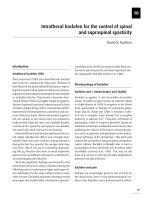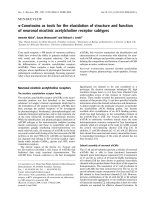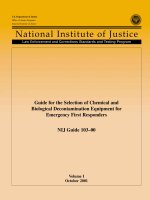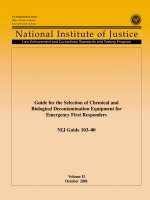- Trang chủ >>
- Khoa Học Tự Nhiên >>
- Vật lý
nanotechnology for the regeneration of hard and soft tissues, 2007, p.260
Bạn đang xem bản rút gọn của tài liệu. Xem và tải ngay bản đầy đủ của tài liệu tại đây (17.84 MB, 259 trang )
Nanitechnology
for the
Regeneration of
Hard and Soft Tissues
This page intentionally left blankThis page intentionally left blank
N E W J E R S E Y
•
LONDON
•
SINGAPORE
•
BEIJING
•
SHANGHAI
•
HONG KONG
•
TA I P E I
•
CHENNAI
World Scientic
Editor
Thomas J Webster
Brown University, USA
Nanitechnology
for the
Regeneration of
Hard and Soft Tissues
British Library Cataloguing-in-Publication Data
A catalogue record for this book is available from the British Library.
For photocopying of material in this volume, please pay a copying fee through the Copyright
Clearance Center, Inc., 222 Rosewood Drive, Danvers, MA 01923, USA. In this case permission to
photocopy is not required from the publisher.
ISBN-13 978-981-270-615-7
ISBN-10 981-270-615-1
All rights reserved. This book, or parts thereof, may not be reproduced in any form or by any means,
electronic or mechanical, including photocopying, recording or any information storage and retrieval
system now known or to be invented, without written permission from the Publisher.
Copyright © 2007 by World Scientific Publishing Co. Pte. Ltd.
Published by
World Scientific Publishing Co. Pte. Ltd.
5 Toh Tuck Link, Singapore 596224
USA office: 27 Warren Street, Suite 401-402, Hackensack, NJ 07601
UK office: 57 Shelton Street, Covent Garden, London WC2H 9HE
Printed in Singapore.
NANOTECHNOLOGY FOR THE REGENERATION OF HARD
AND SOFT TISSUES
Wanda - Nanotechnology.pmd 7/20/2007, 3:50 PM1
This book is dedicated to the next generation of learners,
particularly my daughters Mia and Zoe.
Whatever the challenge, we will find solutions.
This page intentionally left blankThis page intentionally left blank
vii
Preface
This book is centered on a topic everybody is asking. What is the
commercial potential of nanotechnology? Well, look no further than the
integration of nanotechnology into medicine, the so-called area of
research entitled “nanomedicine”. This book covers recent advances in
the design, synthesis, and evaluation of nanomaterials to regenerate hard
and soft tissues. Of course, when discussing how nanomaterials are being
used to regenerate tissues, you cannot omit issues of toxicity. Thus, this
book ends will several chapters concerning the current knowledge base
of nanoparticle toxicity and how to evaluate nanoparticle toxicity.
So, then, what is the real commercial potential for nanotechnology
and, in particular, nanomedicine? Depends on your definition. For
example, if you think nanomedicine refers to Michael Crichton’s self-
replicating nanorobots traversing the body and healing disease (as in his
novel Prey in 2002), I bet you will be waiting a long time (if ever) to see
commercial fruition. On the other hand, if you envision nanomedicine
referring to listening to mediation music from your nanoIPOD (and, thus,
healing your soul), then your in luck as you are already experiencing
commercial benefits of nanotechnology.
But if you are like the rest of us with a more reasonable
interpretation of nanomedicine (the use of nanomaterials in medicine),
you are somewhere in between. While it can be stated that medical
fields (such as implants, imaging, diagnostics, drug delivery, etc.)
are experiencing varying degrees of nanomedicine success, it is safe
to say they all are beginning to see commercialization. Products
have emerged. This includes various nanomaterials (nanoparticles,
nanotubes, nanostructured materials, and nanocomposites), nanotools
(nanolithography tools and scanning probe microscopes), and
nanodevices (nanosensors and nanoelectronics) which are available
commercially, and for some, human use. While to some this may not
Preface
viii
sound significant, consider for a moment the time span numerous
government agencies around the world require to approve new medical
devices for human use. When considering that new pharmaceuticals
require up to 15 years of testing to get through the approval process (and
this is just one example), it is clearly a significant advancement to even
have nanomedicine products on the market.
Certainly, though, the promise of nanotechnology has created lofty
expectations in some quarters. The expectations continue to grow from
year to year. For example, the U.S. National Science Foundation (as one
example) has contributed to this hype. The U.S. National Science
Foundation is on record predicting that the market for nanotechnology,
or products containing nanotechnology, will reach $1 trillion in 10 to 15
years.
1
Clearly, medical products will be a significant part of this
expectation. While both advocates and opponents of nanotechnology
tend to lose sight of the fact that progress in developing commercial
nanotechnology applications has been understandably slow to date, the
excitement is still as high (if not more) than the first day that
nanomedicine emerged over ten years ago.
The expected commercial potential has not decreased or even
remained the same over the past decade; it has only increased. Some
have predicted that nanomedicine will exhibit strong growth in all sectors
until as far out as 2011, leading to multi-billion dollar revenues.
2
Key
nanomedicine technology platforms (such as nanocrystals, nanotubes,
dendrimers, fullerenes, quantum dots and molecular scaffolding) are
expected to drive that market expansion.
2
Few research fields have been
able to sustain and grow such excitement that continues to drive
nanomedicine.
So while in business and academia we are perpetually thinking of the
future and asking what is real commercial potential of nanomedicine, we
should not forget about where we have come. (After all, the worldwide
market for nanoscale devices was 406 million dollars in 2002.
3
) Here, it
is safe to say, that we have already met one important expectation: we
have created products based on nanomedicine principles. Whether we
will meet the continual increasing expectations of nanomedicine remains
to be seen, but it is clear we have passed a significant milestone already
that should put this question to rest. Such milestones and prospects for
the future are emphasized in the following pages of this first-of-a-kind
book. Enjoy.
Preface ix
References
1. , accessed, January 4, 2007.
2. , accessed, January 4, 2007.
3. accessed, January 4, 2007.
T. J. Webster
This page intentionally left blankThis page intentionally left blank
xi
Contents
Preface vii
List of Contributors xix
Chapter 1 Bioinspired Nanocomposites for Orthopedic
Applications 1
Huinan Liu and Thomas J. Webster
1. Introduction 1
2. Basic Science of Bone 3
2.1. Bone Is a Nanostructured Composite 4
2.1.1. Organic Phase: Collagen Nanofibers and
Noncollagenous Proteins 4
2.1.2. Inorganic Phase: Hydroxyapatite Nanocrystals 6
2.2. Microstructure and Macrostructure of Bone 6
2.3. Mechanical Properties of Bone 7
2.4. Bone Remodeling and Bone Cells 8
2.4.1. Osteoblasts 9
2.4.2. Osteocytes 11
2.4.3. Osteoclasts 11
3. Problems of Current Bone Substitutes 12
3.1. Autografts 12
3.2. Allografts and Xenografts 12
3.3. Metal and Metal Alloys 12
4. Bone Tissue Engineering: Promises and Challenges 13
4.1. Essential Requirements for Bone Scaffolds 15
4.1.1. Biocompatibility 15
Contents
xii
4.1.2. Biodegradability 16
4.1.3. Mechanical Properties 16
4.1.4. Surface Properties 16
4.1.5. Osteoinductivity 17
4.1.6. Interconnected Three-Dimensional Structures 17
4.1.7. Feasible Fabrication Techniques and
Sterilizability 18
4.2. The Choices of Materials for Bone Scaffolds 18
4.2.1. Biodegradable Polymers 19
4.2.2. Bioactive Ceramics 25
4.2.3. Ceramic/Polymer Biocomposites 26
5. Nanocomposites: Next-Generation Materials in Orthopedics 27
5.1. Rationale and Evidence 27
5.2. Fabrication Techniques of Biocomposite Scaffolds 30
5.2.1. Solvent-Casting/Particulate-Leaching 30
5.2.2. Gas-Foaming/Particulate-Leaching 33
5.2.3. Phase Separation and Emulsion Freeze Drying 36
5.2.4. Fiber Meshes/Fiber Bonding 39
5.2.5. Melt Molding 39
5.2.6. Freeze Drying and Cross-linking 40
5.2.7. Rapid Prototyping Techniques 40
5.3. Future Directions in Orthopedics 43
Bibliography 43
Chapter 2 Nanomaterials for Better Orthopedics 53
Ganesan Balasundaram
1. Introduction 53
2. Skeletal Complications: Osteoporosis and Bone Fracture 54
3. Need for Better Implantation Materials for Orthopedic
Application 55
3.1. Cell Recognition of Implant Surfaces 57
3.2. Chemistry 59
3.3. Topography 60
4. A New Approach: Nanophase Orthopedic Materials 61
4.1. Benefits of Nanophase Bone Implant Materials 66
Contents
xiii
4.2. Wettability 67
4.3. Surface Roughness 68
5. Influence of Nanomaterials Functionalized with Cell
Adhesive Peptides on Osteoblast Functions 70
6. Future Challenges 72
Bibliography 74
Chapter 3 Anodization: A Promising Nano-modification
Technique for Titanium for Orthopedic
Applications 79
Chang Yao and Thomas J. Webster
1. Introduction 79
2. Anodization of Titanium 81
2.1. Basics of Anodization Process 81
2.2. Influences of Processing Parameters 82
2.3. Creation of Micron-Rough Surface 83
2.4. Creation of Nano-roughness 85
2.5. Control of Chemical Composition 92
3. Structure and Properties of Anodized Oxide Film 94
3.1. Structure 94
3.2. Corrosion Resistance and Adhesive Strength 96
3.3. Biological Properties of Anodized Titanium 97
3.3.1. In vitro Studies 97
3.3.2. Mechanisms of Increased Osteoblast Function 100
3.3.3. In vivo Studies 101
4. Future Directions 105
Bibliography 106
Chapter 4 Bio-inspired Carbon Nano-structures:
Orthopedic Applications 111
Dongwoo Khang
1. Fundamentals of Protein Adsorption and Surface Properties 111
1.1. Adhesion Protein 113
1.2. Polar and Apolar Properties of Proteins 113
1.3. Osteoblasts 115
Contents
xiv
1.4. Carbon Nanotubes and Carbon Nanotube Composites 116
1.5. Cytocompatibility of Carbon Nanotube Composites 118
1.6. Analysis of Nano-surface Roughness 118
1.7. Role of Nano-surface Energy 119
1.8. Detecting Protein Adsorption 120
2. Protein Assisted Osteoblast Adhesion on Nanophase Materials 121
2.1. Osteoblast Functions on Carbon Nanotube
Composite Materials 122
2.2. Fibronectin Attached AFM Tip Interactions on
Carbon Nanotube Composite Surfaces 124
2.3. Osteoblast Functions on Micro-patterning of
Carbon Nanotubes on Bio-polymers 126
3. Conclusions and Summary 130
Bibliography 130
Chapter 5 Applications of Nanotechnology/Nanomaterials
in the Nervous System 135
Peishan Liu-Snyder
1. Anatomy, Physiology and Molecular Biology of the
Nervous System 135
2. Epidemiology, Etiology and Pathophysiologies of
Neurological Disorders 141
2.1. Spinal Cord Injury 141
2.2. Alzheimer’s Disease 143
2.3. Multiple Sclerosis 146
3. Current Clinical Therapies and Limitations 147
3.1. Approved Treatments of SCI and Ongoing Human
Clinical Trials 148
3.2. Pharmacological Treatments of Alzheimer’s Disease and
Ongoing Human Clinical Trials 149
3.3. Pharmacological Treatments of Multiple Sclerosis (MS)
and Ongoing Human Clinical Trials 151
4. Application of Nanotechnology on the Development of Novel
Drug and Cell Delivery Systems for the Nervous System 153
Contents
xv
4.1. Conventional Drug Delivery Systems and Their
Limitations 153
4.2. Advances of Nanotechnology in Drug Delivery Systems 154
4.3. Nano-based Matrix for Stem Cell Delivery 156
4.4. Medical Imaging with Nanotechnology for Early
Detection and Evaluation of Treatment 158
5. Applications of Nanotechnologies in Electronic Tissue
Interface Devices 161
5.1. Cochlear Implant (Bionic Ear) 162
5.2. Visual Prosthesis (Bionic Eye) 163
5.3. Computer Brain Interface (BrainGate Technology) 164
5.4. Functional Electrical Stimulation (FES) 165
5.5. Memory and Cognitive Functions 166
5.6. Oscillating Field Stimulator (OFS) 166
6. How Can Nanotechnology Improve Performance of
Electronic Tissue Interface Devices? 167
7. Future Directions and Considerations 170
Bibliography 171
Chapter 6 Vascular Nano Stents 181
Karen M. Haberstroh
1. Physiology of the Vascular System 181
1.1. Structure and Function of the Arterial System 181
1.2. Components of the Artery Wall 182
1.3. Cells of the Vascular System 183
1.3.1. Vascular Endothelial Cells 183
1.3.2. Vascular Smooth Muscle Cells 184
1.3.3. Vascular Fibroblasts 184
1.3.4. Blood Cells 185
2. Atherosclerosis: A Cardiovascular Disease 185
2.1. The Cellular Progression of Atherosclerosis 186
3. Treatments for Vascular Disease 187
3.1. Balloon Angioplasty 188
3.2. Vascular Stents 189
Contents
xvi
3.2.1. The Use of Nano-structured Biomaterials in
Vascular Stent Applications 190
3.2.2. Problems with Current Stent Designs 192
3.2.3. Stent Wear Debris 193
4. Conclusions 196
Bibliography 196
Chapter 7 Nanoparticles: Determining Toxicity 201
Ezharul Hoque Chowdhury and Toshihiro Akaike
1. Introduction 201
2. Strategies for Biocompatibility Testing 202
2.1. Cytotoxicity 202
2.2. Sensitization, Irritation and Intracutaneous Reactivity 203
2.3. Acute Systemic Toxicity 203
2.4. Genotoxicity 204
2.5. Implantation 204
2.6. Hemacompatibility 205
2.7. Subchronic and Chronic Toxicity 205
2.8. Carcinogenicity 205
2.9. Reproductive and Developmental Toxicity 206
2.10. Biodegradation 206
2.11. Immune Responses 206
3. Route of Entry and Biokinetics of Nanoparticles 207
3.1. Respiratory Tract 207
3.1.1. Alveolar Macrophage-Mediated Clearance 208
3.1.2. Translocation across Epithelial and
Endothelial Cell Layers 208
3.1.3. Neural Uptake and Translocation 209
3.2. Exposure via GI Tract and Skin 210
3.3. Injection Route 210
4. Biological Adverse Effects of Nanoparticles 211
4.1. Pulmonary Effects of Nanoparticles 211
4.1.1. Pulmonary Inflammation 212
4.1.2. Pulmonary Carcinogenicity 213
4.2. Systemic Effects of Nanoparticles 214
Contents
xvii
4.3. Differences in Toxicity between Nanoparticles of
Different Materials 215
4.3.1. Particle Surface Activity 216
4.3.2. Particle Agglomeration/Disagglomeration 216
5. Conclusions 216
Bibliography 217
Chapter 8 Nanoparticles: Effects on Human Health and
the Environment 221
Myung-Haing Cho and Jin-Kyu Lee
1. Hopes and Concerns about Nanotechnology 221
2. Possible Adverse Health, Environment, and Safety Impacts 224
3. How to Evaluate the Toxicity of Nanoparticles? 226
4. Conclusions 231
Acknowledgements 232
Bibliography 232
Index 235
This page intentionally left blankThis page intentionally left blank
xix
List of Contributors
Toshihiro Akaike
Professor
Department of Biomolecular Engineering
Graduate School of Bioscience and Biotechnology
Tokyo Institute of Technology
4259 Nagatsuta, Midoriku,
Yokohama 226-8501
Japan
Ganesan Balasundaram
Senior Staff Scientist
IFC Medical
2605 Fernbrook Ln N, Suite G
Plymouth, MN 55447
USA
Myung-Haing Cho
Professor
Laboratory of Toxicology
College of Veterinary Medicine
Nano Systems Institute–National Core Research Center
Seoul National University
Seoul 151-742
Korea
List of Contributors xx
Ezharul Hoque Chowdhury
PhD Candidate
Department of Biomolecular Engineering
Graduate School of Bioscience and Biotechnology
Tokyo Institute of Technology
4259 Nagatsuta, Midoriku,
Yokohama 226-8501
Japan
Karen M. Haberstroh
Director of STEM Outreach and Assistant Professor
Division of Engineering
Brown University
184 Hope Street
Providence, RI 02917
USA
Dongwoo Khang
Post-Doctoral Researcher
Division of Engineering
Brown University
184 Hope Street
Providence, RI 02917
USA
Jin-Kyu Lee
Professor
Materials Chemistry Laboratory
School of Chemistry
Nano Systems Institute–National Core Research Center
Seoul National University
Seoul 151-742
Korea
List of Contributors xxi
Huinan Liu
PhD Candidate
Division of Engineering
Brown University
184 Hope Street
Providence, RI 02917
USA
Peishan Liu-Snyder
Post-Doctoral Researcher
Division of Engineering
Brown University
184 Hope Street
Providence, RI 02917
USA
Thomas J. Webster
Associate Professor
Division of Engineering and Department of Orthopedic Surgery
Brown University
184 Hope Street
Providence, RI 02917
USA
Chang Yao
PhD Candidate
Division of Engineering
Brown University
184 Hope Street
Providence, RI 02917
USA
This page intentionally left blankThis page intentionally left blank
1
Chapter 1
Bioinspired Nanocomposites for
Orthopedic Applications
Huinan Liu and Thomas J. Webster
1. Introduction
An estimated 1.5 million individuals in the United States suffer a fracture
caused by some form of bone disease annually.
1
Most adverse effects of
bone diseases relate to fractures. Osteoporosis is a leading underlying
cause of bone fractures which affect both males and females at all ages,
although to varying degrees. Other bone disorders, such as Paget’s
disease, osteogenesis imperfecta, rickets, and osteomalacia also have
adverse influences on bone structure, strength, and density, and
subsequently lead to bone fractures.
Orthopedic prostheses are often required to repair or replace
damaged bone tissue due to those diseases, injuries or genetic
malformations. In 2001, about 165,000 hip joints and 326,000 knees
were replaced in hospitals in the United States according to the National
Center for Health Statistics.
2
Direct care expenditures for fractures such
as surgery and therapy cost approximately 18 billion dollars per year in
the United States. Indirect costs such as lost productivity for patients may
add billions of dollars to this figure.
1
In the coming decades, these costs
could increase in double or triple if surgical removal and revisions
become necessary after implantation when an orthopedic implant fails
under physiological loading conditions. A majority of those patients who
receive an orthopedic implant may have to undergo several revision
surgeries in their lifetime since the average longevity of current
orthopedic implants is only 10 to 15 years.
3
Therefore, in order to
decrease patient discomfort and costs, designing the next generation of
Nanotechnology for the Regeneration of Hard and Soft Tissues
2
orthopedic prostheses with improved clinical efficacy and longer
effective lifetimes is a principal task of researchers in the biomaterials
field.
Over the past 25 years, researchers have been interested in applying
composites to satisfy a wide diversity of biomedical demands
considering that living tissue are composed of composites with a number
of levels of hierarchy. In almost all biological systems a range of
properties is required, such as physicochemical properties, mechanical
properties, and biological activity, which are all of great importance to
the clinical success of biomaterials. The development of bioinspired
nanocomposites offers the great promise to improve the efficacy of
current orthopedic implants. Specifically, for organic/inorganic
biocomposites, it is possible to obtain a wide range of mechanical and
biological properties by modifying the type and distribution of inorganic
phase in the organic matrix and hence to optimize the performance of the
biomedical devices and their interaction with the host tissues. A wide
variety of biocomposites have been synthesized and fabricated for
various biomedical applications during these years. The general class of
organic/inorganic nanocomposites is a fast growing area of research.
Significant effort is focused on the ability to obtain control of the nano-
scale structures via innovative synthetic approaches. The properties of
nano-composite materials depend not only on the properties of their
individual components but also on their fabrication techniques which
have significant influences on the structure, morphology, distribution of
phases and interfacial characteristics of nanocomposites.
For potential applications to be successful, full advantage must be
taken of the comprehensive properties of biocomposites and the
advanced manufacturing techniques to meet the needs of biomedical
applications. This chapter systematically addresses nanocomposites
applied to repair or replace damaged bone tissue in a comprehensive
manner, and emphasizes on the influence of nanotechnology on
fabrication of nanocomposites and their applications in tissue
engineering.
This chapter focuses on three main areas. First, it introduces natural
bone and widely used synthetic composites in natural bone repair.
Second, the requirements of biocomposites in nano-scale structures for









